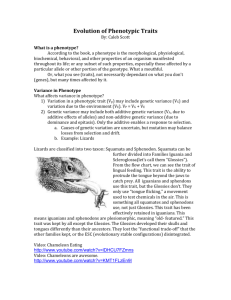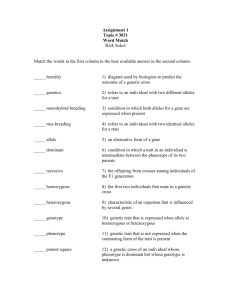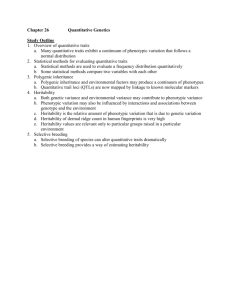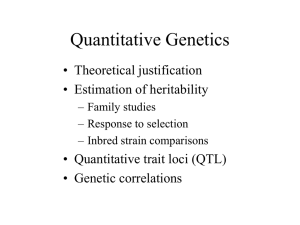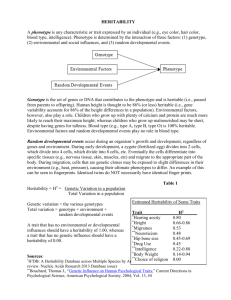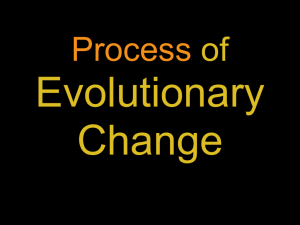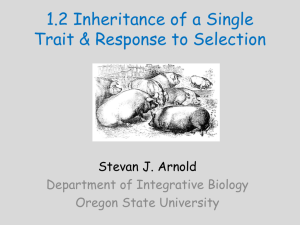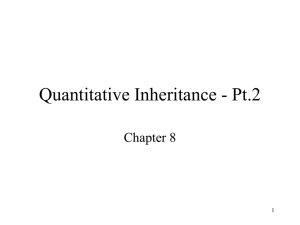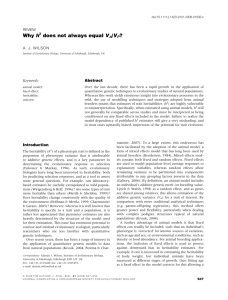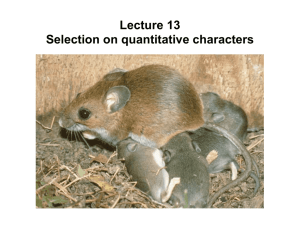Polygenic inheritance, quantitative genetics and heritability
advertisement
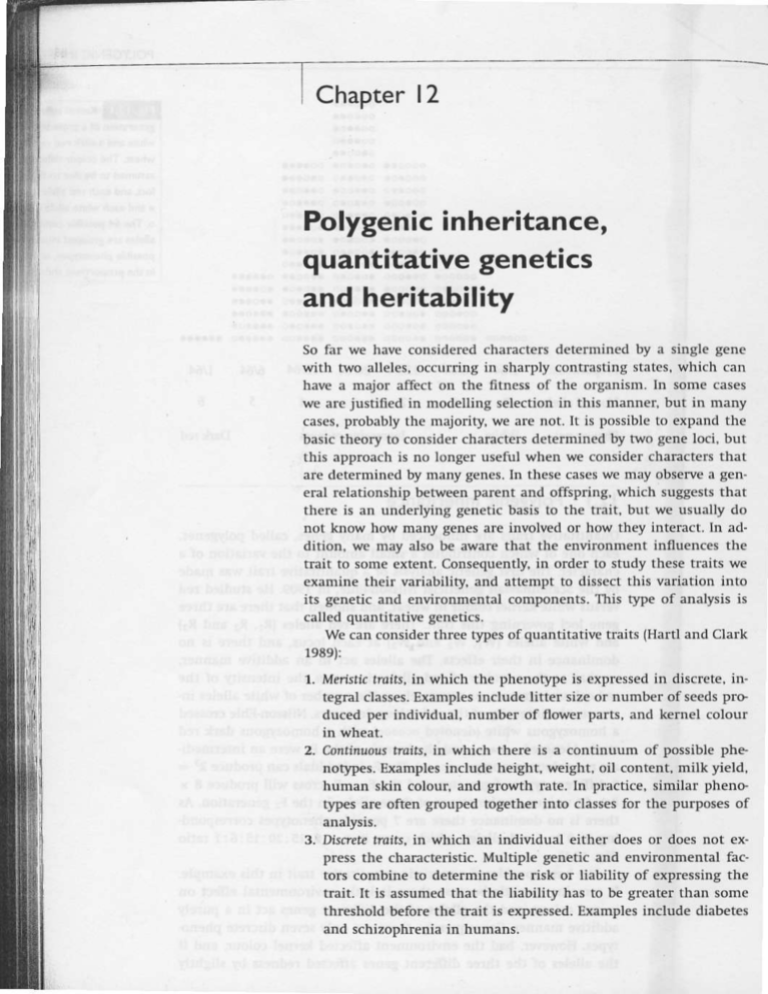
Chapterl2
'i
r
Polygenicinheritance,
quantitative genetics
and heritability
So far w€ haveconsideredcharactersdet€rminedby a single gene
with two alleles.occurringin sharplycontmstingstates.which can
have a major afftct on the fitnesi of the organism.In some cases
we xr€ justified in modellingsel€ctionin this manner.bùt in many
cas€s,prcbablythe majority,w€ are not. It is polsibleto expandthe
basictheory to considerchanctersdeterminedby two geneloci, but
this npproachis no longerùsefulwhen we considercharactersthat
are determinedby manygenes.ln thes€caseswe may obsen'€a general r€lationshipbetweenparentand offsp ng, which suggefs that
there is an underllng geneticbalis to the trait, but we usually do
not krìow how many genesare involvedor how they interact.In ad.
dition, we may also be awarethat the environmentinflu€ncesthe
trait to someextent.Coffequendy,in order to study th€setraits w€
examinetheir variability,and atr€mpt to dissectthis variation inio
its g€neticand enúrolmental components.This type of analysisis
calledquantitati\€gen€tics.
We can coDsiderthre€typesofquantitarivetraits (Hartland Clark
1989):
1 . Mrdstictroits,in which the pheùot)?€is expressed
in discrete,in-
tegralclasses.
Examplesincludelitter sizeor numberofseedspro
ducedper individìral,number of flower parts,and kemel colour
Continrors|'ol'l, in which there is a continuum of possiblephè
notpes. Examplesinclùdeheight,w€ight,oil content.milk yield,
humaD skin colour.and grcwth rate. In practi€e,similar phena
typ€s are oft€n grouped togetlìer into classesfor the purpos€s of
anaÌysis,
Dlsr'eteraitr. in which an individual either doesor doesnot express the characteristic. Multiple gen€tic and environmental factors combineto determinethe dsk or liability of expressingthe
trait. It is assumedthat the liability has to be greaterthan some
threshold befoÉ the ùait is expressed.Examplesinclude diabetes
and schizophrenia
in humans.
/
POLYGENIC
INHERITANCE
I
whhèanda darkrenúri€ry ol
whedLThècolourdifcrèncèir
r$um€dto bedù€to rhr.. g€n.
lo.i, and.rch Èd:ll.le k d€nor.d
. lnd ech whiÈàll.l€ is dènoÈd
,,. rh.6,1 p.ssibl€combinrtion
ol
.llol.i irc Eroup€d
inb th. rd.n
pós blepheno9pes,
whlchoccur
ln ihè pbpÒrtlonslhown.
PropÒrlionsi
No. rcd aìleles:
Phcnolypei
l/64
0
6164
15164 20t64 15t64
I
Whitc
|/(a
6
Darkred
inheritance
12.I I Polygenic
quaDtitative traits are inlluenced by many genes. called polygcnes,
each one ofwhich contributes a small amouDt to the vàriation of .l
character.The flrst g€netic .ìnàlysisof a quantitative trait was nadc
by the Scandinaviangeneticist Nilsson-Ehle,in 1909. He studied red
vcrsus white kernel colour in wheat, and showcd that there are three
gcnc loci governing this trait. There are red.llelcs (Rr, R, and Rr)
and white allel€s W!, W, and W3l at each locus, and there is no
domnlance in their effecrs. lh€ alleles act in an additive manner,
so that as the numbcr of red alleles increases the intensity of thc
red colour increases,or converselyas the number ofwlìile allel€s increasesthe intensity ofthe red colour decrcases.Nilsson-Ehlecrossed
a homozygous whit€ {denoted oooooo)with a homozygous dark rcd
strain {denoted ......) and the kernels of rhe !1 w€re an interm€diare red colour (genotypeo.ó.o.). The F, indrvidùals can produce 21 =
6 diflerent t)?es of gametes, and the Fr x Fr cross will produce 6 x
8 = 64 unique combinations of these alleles in the F, generation. As
there is no dominance there arc 7 possible phenotypes correspoDdi n g t o O t o 6 r e d a l l e l e s ,w h i c h o c c u r i n a 1 : 6 : 1 5 : 2 0 : 1 5 : 6 : 1 r a t i o
(Fig. 12.1).
We have considered a meristic quantitative trail in this €xampl€.
It remains meristic because there is Ìittle environmental eff€ct on
kernel colour, and the alleles of the different genes act in a purely
additive manner Consequently, there are only seven discrete phena
B?es. However, had the envimnment affected kernel colour, and if
the allel€s of the three different gen€s affected rcdness by slightly
ta7
GENETICS
QUANTITATIVE
contlnuols dlrribuiló. ol kérn.l
PrcPoriont ol lhe diffaÉnt
gènoryP6rcm.h thc ..he.r h
fig. ! 2-I, but .nùrcnn.nbl úd
oÌhcr 8èn.rìc.tf€cBblurrh.
dìrindion b.vén difcrenr
'i
5E
g';
ÈP
gB
1o
12345
Bed Inlensltyol kernels
different amounts,the boundariesbetweenthe ph€not,?eswould
becom€blurred so that therewould be more or lessa continuum in
kern€lcolour ftom white to dark rcd. In this case,the disúibution of
keînel colorlrwould follow a smooth cun€ (Iig. 12.2)followingthe
generatshapeof the histogramin Fig. 12.1.To analysesúch 3 continuous distributionofkernel colour w€ might arbitrarilygroup the
colours into sevenclasseswhich would be r€lated in someMtayto th€
number of red allelesper individual.Thùs,we can seethat there is
reallyno distinctionbetweenth€ first two typesofquantitativetrails
li.e.medsticand continuousì.
12.2| Partidoningphenotypicvariationinto
I differentcomoonents
The flrst attempt to partition phenotypic variation into its genetic
and environmentalcomponentswas made by East(1916)who began
his experirnents on the flower length of Nicohara loîEúlorq i^ 1912We will use his alata iD the following two subsectionsto show how
phenotypic vaiation cen b€ pertitioned into its various components.
Our method of analysisis kept simple for obviousreasons,aDdyou
shouldbe awarethat it is not applicablein aÌt situations.Someof the
dimculties wiU be briefly meotioned as vr€ developour anÀlysis.but
for now let us consider our ùse of the similarity betw€€n parctrt and
offspring to measure the gen€tic basis of a trait. Behavioural traits
may be genetically transmitted fiom parent to offspring but may also
be modified or teùght by tlìe parents, and our method ofanalysis does
not distinglish b€tween thes€ t\'o modes of ùansmission. A more
complex exampleis provided hy th€ body weight of eutherian mammals. Aù individual's body ueight at the time of weaning dependson
the body w€ight of the par€nts (genetic tmnsmissior), it! weight at
birth and the emount of úilk it rcceives.vrhich are influenced by the
nutritional status of tle moth€r and the litter size or lrumber of siblings (Fansmission of maternaì and sibling environmental eff€cts).
PARTITIONING
PHENOT"YPIC
VARIATON
Corollalengih(classcentres,mm)
c'
il orrf
e'""ai"e
!@
"n"'i'*
on flowef en8lh n Ni.oriono
ffi
I
E
z
:l
'"8',
Fr
r[
(DaErrcmEó! le16.)
Lroisirtùd.
ù
Ccncli(ists use a vnricty of metlìods to ovefcome thesc diffjculries
and Dìore accrìr)îcly prrtition tlìe ph€notypic variance into ils diftercnt componc,lts {seelalconcr nnd Mîckay 1996),but rhey arc more
conplex ànd arc beyond thc scopc ofthis tert.
12.2.I Geneticandenvironmental
components
The phenolypic variance can be c:ìlculrred in a stl.aigbrlorwnrd lllanncr, describ€d in rny statistics t€xl, as th€ averrge of the squared
devintions about the 'llcan phenotypic value. Phcnorypic variarion
is divided into its gcn€tic and environmental conrpoD€ntsby assrF
ing ÙaÌ these sources ofvariation ar€ addiliv€. lf îhis is the case,
thc totnl ph€notypic varian(e (Vp)equals the fraciioD of rhe phenc
typic variance that is a rcsult of genetic differences berween individuals (yc) plus lhe ffa.tion of the phenotypic variance ì.esulting
ftonì ditrerencesin the environnìental conditions ro which indiùduals were exposed(VE).Synbolicàlly this is writterì:
{Iqr 12.1)
East partitioned th€ variation in flower length iD the following
way. H€ €mssed homozygous long-flower€dplants with homorygoùs
shorÈfloweredplants, aDd th€ resulting F, pÌants, which w€re genet,
ically identical to one another. had flowers of intermediate lengrh
(Fig. 12.3).There was no genetic varlation (i.€. yc = 0) in either of
the parental varieties or the Fr offspdng, and so the observedvariance within these sroùps (Vr)cquals th€ environmental vaúatrce,VE.
The averagevariance ofthese three groups, yE, equalled 5.2 for Eastl
East then made a cross oflr individuals to produce the F, generation- The alleles inhe ted from th€ two parenraÌ strains segregated,
QUANTITAIIVEGENETICS
and so the total ph€notypic varianc€ ofthe f, was made up of both
genetic and environmental v3riation. The total phe[otyPic variance
(Vp)of th€ F, offsp ng was 40.s.The geneticvadance(Vc)car then
b€ calculated by rearranging Eqn 12.1as vc = vp - vE. which gives a
valùeof35.3.
ln sùmmary by analysingEasth data on the phenotypicvalia.
tion of flower length in Ni.otiono, it is possible to partition the tù
tal phenotlTic variatior (Vp- 40.s) into its environmental {y[ - 5.21
and genetic (yc = 35.3)componenB by assultìing tlìat thele sources
of varietion are additi!€. Thus, in the I, generatìonapproximately
87%of th€ vari:tion was geneticallybasedand 13%environmental
based.
we can mike two generalpoints about this pafitioning of phè
notypic variation.Firf, the amount of variation (yp)and the rela.
tir€ str€ngths of the genetic and environmental effects Àr€ not 6xed
entities. We may note ihat the value of Vc vaied fiom zero, when
the crosses
werebetweengeneticallyidenticalplants,to 35.3for the
betweenother
Fl x Ir cross.and it wouldb€ differentagainfor crosses
genotypes.Inaddition,if the plantshadb€engfown in a morehetero
geneousenvironm€nt w€ rrould expect to seeVr increasefor obvious
reasons.
Mofeover,
forsometrait! therc canbe genot,?Hnvironment
interactionwheft somegenotypesdo better in some€nviÉnments,
and other genotyp€s do better in others. Consequentlt the ov€rall
phenoO?icvariationand the relatirrEirnportanceof the geneticand
environmentelcomponentsvary accordingto the envitonmentand
the prechegEneticmakèup ofthe population.
sccond,our partitioningof phenotypicvariationdo€snot give an
unequ ocal answerto the old genetì(s"versus4nvifonment
or 'naturÈ
veEus-nurture'debate.ln our exemplEof flower length it looks as
though it is more imf,ortant to hav€ th€ 'right' g€ner rather that
environment if w€ want a flower of a specinc l€nglh. However, if
w€ ody had an inbred line wìth low genetic diversity. the reverse
might be true. The debate has been highly €motioúl at times, and
the opposing sides har€ oft€n taken extreme positions, claiming
either lhat only geneticvariationis importantlgeneticdetelminism)
or that the environment(nurture) is all-important.In rcality it is
a mixtur€ of thes€ two compoùents that determines phenotypic expr€ssion,although their relative importance can ìruy, How€r,er,as lr,e
have seen, their relative importance is not ffxed and so the debate
continues without final rEsolution for some people. We will look at
t\^,o €xamples of îhis debate in more d€tail. in s€ction 12.6 0f this
chapterand in Chapter19 {section19.r).
12.2.2 Partirioning
the components
ofgeneticvariation
The genetic variance (vc) is also made up ofa number ofcomponentsThese compon€nts include the additi\'€ effects of all of the alleles
that affect the trait, the dominance eff€cts between alleles within
gene loci, and epistatic int€ractions betw€€n different gen€ loci that
pARTrroNrNG
pHENOTypTC
vARrAíiON
modirythe additiveeffects.To help us understandhow the additive,
dominance and epistatic effects c:n influence the genetic variance,
consider the following hypotlÌetical series:
Genotype
AABb AABB
2. Dominance
effect
plus
3. Dominance
Imaginc that this correspondsto a sitùation similar to that of kernel coloùr in wheat {section 12.1),but thcre are only two genc
loci involvedand thc red allelesare represcntedby capital letters.
When thereare purelyadditi!€ effects,the red colourintensifesin a
stepwisefashion(C-4)as eachred alteleis added.Now imaginethat
the red alleleis completelydominantto white.asshownin the second
exampìe.The intensityofthe red colourwould be the samewhether
on€or both allelesofn genecod€dfor red,and the phenotypicscor€s
would be modified as shown.Finally.in th€ third €xamplewe can
imaginethat the A allel€ only exertsils €ff€ctin th€ prcsenceof allele D, and so there would be a further modificationof phenotypic
Thus,it is necessary
to partition the geneticvariance,Vc,into the
variouscomponentsas follows:
(Eqn 12.2)
in which y^ is lhe variancedue to the additiveeffectsof alleles,
VDis the variancedue to dominanceeffectsbetweenallelesand y|
is the variancedue to €pistaticinteractionsbetweenthe genesthat
affecr the rrait. In prictice, ir is difficulr ro s€paÉr€ vD afid yr and
consequently
they are often groùpedtogeth€ras nor-additivegenetic
The additii€ geneticvarianc€{V^)is the main causeofùe resemblance b€tw€en parents and their offspring, and between rehtives.
We can obtain a mealure of this r€lationship by drawing a graph of
the meanphenoq?icscoreofoffspring againstthe meanphenotypic
scoreoftheir parents.Ideally,th€ parcntsshouldbe matedat rardom
when consùucting thes€gnphs, which ca$ then be ùs€d to caÌculat€
v^ (seebelow), lf wE consid€r our €xampl€ of flower length in NlcÈ
tlon , and use the data fiom crossesftom the F2geneútion prcvided
in East (1916),we obtain the following rclationship between parent
atrd offsprins (Fis. 12.a).
l'
I
GENETICS
QUANTITATIVE
l!@l'"tr.,i*'r'ip.pàren$
ind
fìok. lèngthb€*e€n
ofispringin Ni.oro.o loigifoE.
slope= 0.8348
5a
=
Mean flower lenglh ol paients (mm)
The slopeof the regressiontells us how much th€ offspring re
sembletheir parents,or what is called the hentubilityin thercrrow
(h'?N)
sense
of the trait.r Thus,if the offspringhavethe sameaverage
phenot)?ic scoreas th€ir parents,the slopeof the regression(h'zN)
will be 1.0,and if there is no relationshipin the phenoo?ic scores
of parentsand their offspring,then h'zN= 0. Obviously,the higher
the heritability(or slopeofth€ regression)
the largerthe additiveg€netlc component.Therelationshipbetweenheritability(h'zN),
addiriv€
gen€ticvariance(y^) and phenoLic variance(Vp)is gi!€n by:
(Eqnr2.l)
From Eastl data (!ig. 12.4)we seethar iuN = 0.8348for flower
length in Nicoiraflo.Insection12.2.1,
we noted that yrì = 40.5,and so
we can estimarey^ as 0.8348x 40.5= 33.8by rearra[gingEqn 12.3.
We haveprevioully eslimatedthe geneticva ance (Vclas 35.3,and
so from Eqn 12.2we can estimatethe non-additivegeneticvariance
(VD+ Yr)as 35.3 33.E= 1.s.
This completesour partitioning of the phenoù?ic variation into
its variousgeneticard €nvironmentalcomponents,and the results
are summarizedin Table12.1.Thegeneticvarian€e(Vc)is the sum of
the additiveand non-additivegeneticvariances,and equals35-3,or
87%ofthe toral ph€notypicvariance.
12.3 Heritability
We havejust seenthat heritability in the narrow sense(h,N)is the
proportionofthe total phenotpic variationihat is a resultofaddirive
geneticvariation (Eqn12.3).Yoù shoìrldalso be awarethat there is
another measureof heritability,called à€ritabilttyh the brondsmse
rTlì. dcglcc ofgcù.ric JrtcrnÌi.îiio., or hcritrbjlrù. of a Ìmjt is syorìrolizcJ
tr\ hl
b e . a n siet w r s n s t . r L ù h r . d a \ t h . f t ù a r eo f r h e p r i a l . o . r È h u u n . o t l î . ì d ntri e
prù (orfh.ientl lrerwùenrhe pmúrrl senoîypcirnd rhc ottitriù!\ phenarypcF..
HERITABILfi
l2-1. I P.rúr@iDg of ÉE v.ii.tnn of lmr l6gth in Xùd@ Ltrgi
cornPo[!* u erpncsea h t tB of th.n ErirùG and s per.
Îh.
,or!,
cnia$r ofth. total phetrott?lcvàriefte
Variance Percentage
Add tive genetc varance
Non-addrtivegeneticvariance
variance
Environmental
V1
40.5
13.8
t.5
5.2
t00
t3
Data from East(1916).
Sou/ce:
(h's)which is equal to Vclyp.We will not considerthis measureany
further, and whereverheritabiìity is referrcd to in this chapterit
meansheritabilityin the narrowsense.
The (€rm heritability has unfortunate connotations,and is fre.
quendy misunderstood,particularlyby non-biologists.
Many people
belielr it is a ffxed propertyfor a particular trair, and think rhar a
characteris geneticallydetcrmìnedto a certainextentand is modified
bythe environmentby someother,usuallysmall,amount.This is not
the case.Heritebility is simply a ratio of two variances,and is only
applicableto the populationand envircnmentin which it was measùred.We can understandthis ifwe expandEqn 12.3to:
(Exp.12.1)
The valueof hzNis changedif we changethe geneticconstitution
of the populationbecausethe varianceofat leastone of the genetic
componettswill be altered.For example.if we had estimatedthe
heritability of flow€r l€ngth for either of the two par€ntal populatiods
of Àlicoliom we would hai€ obtained values of 0 lzerol, inst€ad of
the valueof0.8348estimatedin section12.2.2.
This is becausethere
is rio geneticveriation (Vc and V^ = 0) in thesetwo homozygous
poputations,and all of the vadetion is a rcsult of environmental
vadation (vE).Similarly, changesto the environm€nt c:n also chang€
tl€ value of h'N. For example,height might havea high heritabitity
for a population of plants grown under very uniform conditions, bút
ifwE grew th€ samegeretic stock in an?rea where the soil and water
conditions rr€re exEemelyvariable, the heritability would b€ lov/€red
becaus€the environmentalvariance(VE)would incÉase.
Beadng this in mind when $p compare tlte heritabilities of different chancteristics, we fird that tlle heritability of Fivial, appal€nù
unimportant charactedsticsis frequendy high, whereasthe heútabil.
ity is ùsùally Ìow for characteristics that are closely related to fit
ness flabte 12.2ì.This is becaùseselectior on trivial characterswill
Fobably be low or non-€xist€nt, and so natural selection tolerates
large geneticvariability in thesechamcteristics.Hovreverthere will be
strong selection pr€ssuresoo traits that play a vital role in the fltness
of an organism, aùd so generally there will be much lels genetic
1
GENETICS
QUANTITATIVE
Tabl. | 2,2 I ^pprodEate Elu6 of the bditabnity of v|Itorr cbuct E t!
cllúln dom.rdc |ltrEt ùd plút ?Èies. TEit' cl@lt rrlr6d to nh*
lè.S,calv|lU tnù.rFl, .gtr F h€u.UtÈl sia of sire, l.ld .rtd €rI rMb.r
of coir) teìd ùoha\,€los, Mtrblid6
Specles
andtrait
Catlle
Wfter helght
Milkpmteinpercenlage
Feed€mciency
Milkyi€ld
Calvnginterva
0.ó0
0.55
0.35
0.30
0.25
Eg8we ght
Bodywei8ht
Alb!rnencontent
Ageofsexlalmaturty
Eggsper hen
0.55
0.50
040
0.15
00
Eacklatthickness
Bodylength
Feedemclency
Dailygainin weight
0.60
Swne
com (zea nays)
Huskenenslon
Plantheight
Eafheight
Earn!mber
Yed
0.15
0.30
0.r5
0.ó7
0.53
0.45
0.20
0 .t 3
Sorrce;Data from Haîtl and Clark (1989),
variationbecausethe inferior genotDeswill be eliminatedflom the
popuÌation.
Plant:nd animalbreedersareinterestedin the heitabilities ofdiffereùt characteristicsbecaùscthe higher the heritability, the greater
the rcsponse to selection. This leads us to oùr next topic where wE
consider tle effect of selection otr ouantitativ€ characters.
12.4ì Response
to selection
How do quantitatir€ charactersÉspond to selection?ln many cases
tlìey will change, and w€ can illustBte this olEr two generations of
selectionusing an abstractexample(Fig.12.5).The phenotypicscore
is aúitrary, and could correspond to su.h uaits es the amount of
oil in a seed, plant height. the degree of resistaùce to a particular insecticide, or body \r€ight. W€ apply systematicselection to in"
cr€asethe size of th€ characterin question.In th€ original population
RESPONSE
IO sELECiiON I
seledion lor in.re$€d size ot:
tnft wth i henEbilir/ o10.5, The
individurk relectedb be the
PiÈnB of $e nerSènèhtion àrè
3
5
YS
l\reanattertwo
generations
ol
selection
12345678
Phenotyplc score
(Fig. 12.sa)we can se€ that th€ overall phenorypicmear of the
parentalpopulation(ip) is 3 units, analthe group of individuatss€.
lecredds pdrenrsor rhe nexl Benerarionhavern overa mean(is) of
5 uDitsThe intensityof selection,or selectionprcssur€,being apptiedis
called tlìe sele.tiondilf ential lS), and is measured as the diff€rence
beMeenthe meanof (he selecled
parenrs(ic) and rhe meanof d
the individuals in the parental popùlation (iF). Tlìus:
(Iqn 12.a)
